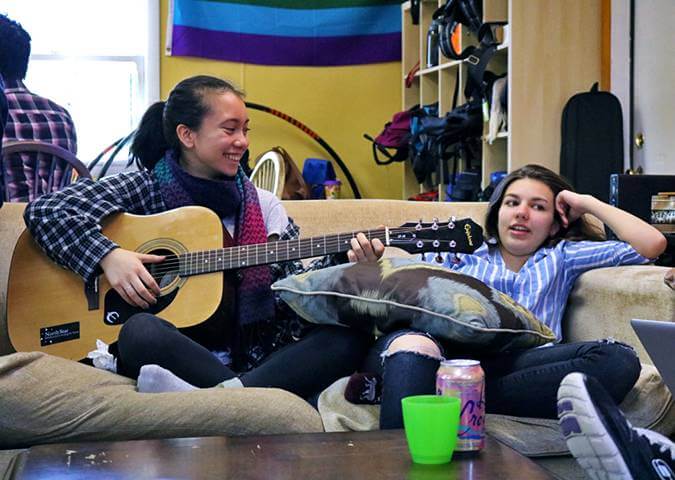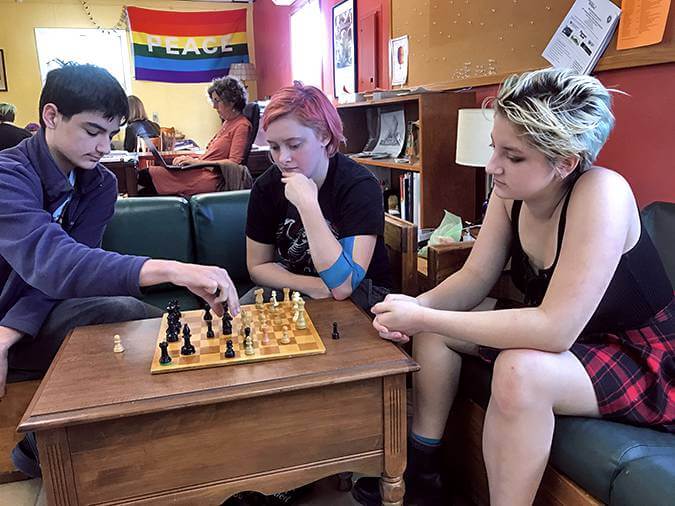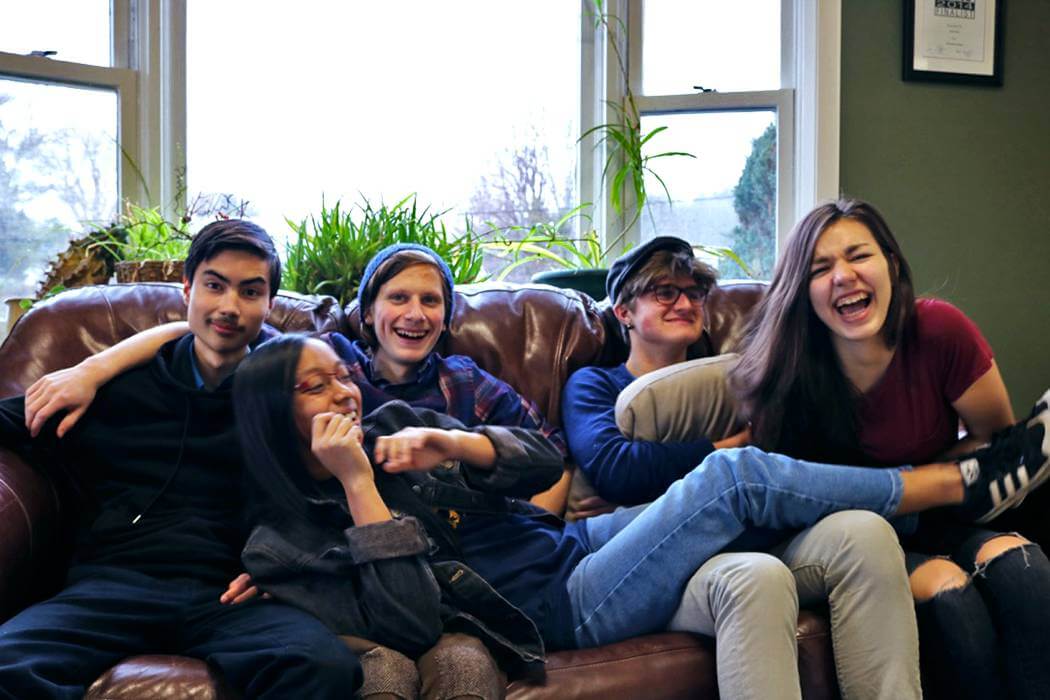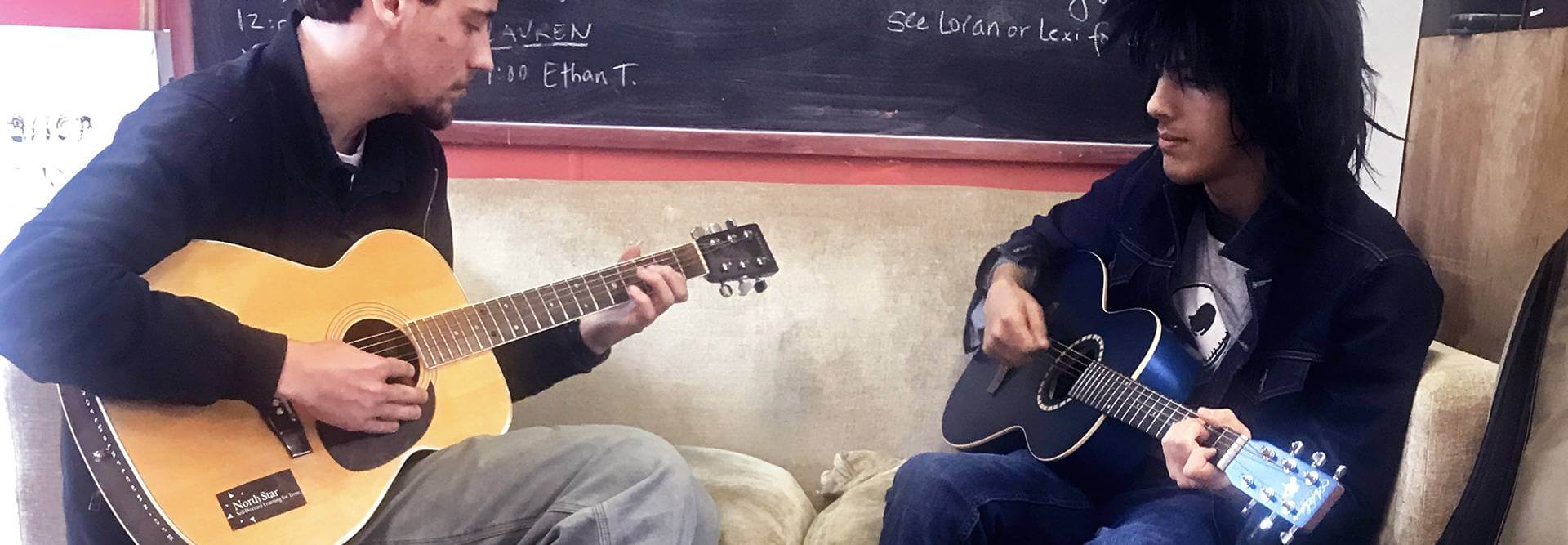The Incident*
In the North Star common room, Kevin was strumming on his guitar while sitting in the back corner with a group of friends. Across the room, I was sitting at a desk working, and a few other students were in the room as well. With a few staff out on this particular day, I was the only adult present, providing the staff coverage we agree is necessary in our common room.
The group of young people in the corner had been a bit loud and rambunctious all day, and I was growing a bit frustrated at asking them to please restrain their volume or take themselves to another room or outside. Still, the situation was in familiar territory until Kevin started harshly and discordantly playing some loud chords on his guitar. I actually couldn’t focus on my work with this noise coming at me from across the room. I stood up, walked over to the group, and said, “Kevin, do you mind? I can’t concentrate when you are doing that with the guitar. I’ve enjoyed listening to you play for the last hour, but I can’t manage what you are doing now. Could you either stop it and go back to what you were playing before, or play this new noise super quietly, or just take the guitar to another room?”
I really like Kevin, and I feel like we have a good relationship. I was somewhat shocked when he stared back at me and said, “What? Are you criticizing my playing? I’m just playing the guitar! We can do that in the common room!” I wasn’t sure if he was joking with me, but I could see in his eyes and gaze that he was serious. Actually, he was growing angry, and this moment was turning into a scene in front of his friends. He continued, “I’m practicing, Ken. Can’t I do that? I’m trying something new here.” He sounded offended at my musical judgment as well as annoyed at my adult authoritarian intervention to ask him to stop what he was doing. Kevin was still sitting on the couch, guitar in hand, glaring at me, and about five other kids were intently watching the exchange.
Kevin was now breathing more heavily and more visibly upset: “It’s kind of mean for you to walk over here and say you don’t like my music. I think this is your problem, not mine.”

Oops. This conflict was not what I intended or desired, but we do have a procedure for these moments at North Star. The first step is to have a private meeting with a staff member and any other relevant or desired witnesses.
I said, “Kevin, I see you are angry. I’m sorry about that. Let’s go talk privately. Any one here is welcome to join us. Is there anyone you want to have come with us?” To the group I said, “Would any of you like to come as witnesses to what just happened to help us resolve it?” Unfortunately, there was not another adult available to join me and mediate the conversation, an unusual moment at North Star. Nevertheless, I decided it was worth proceeding, mostly because I felt Kevin and I had a good history up to this moment and I thought I could manage the discussion on my own. Otherwise, I might have chosen to delay the conversation until I could bring in a second adult.
Our policy is that Kevin could not refuse and continue sitting there. When a conflict resolution meeting is called, both parties must stop what they are doing to discuss the situation. A person who refuses a meeting will be asked to leave the premises, and will not be welcome back until they are ready to have this conversation.
At first, none of the other teens wanted to join us, but by the time Kevin and I sat down in my office, there was a knock on the door and three boys came into the room. I was glad for their presence, as I was a bit wary of going in circles with Kevin one-on-one. A second adult can ensure that any bias by the first adult might be recognized and called out, and also help the teen feel that they are not stuck alone with a person with whom they are already in conflict. In this case, I felt the three boys could help provide those services to both of us.
The first thing I said was, “Kevin, I want you to know I really like you, and I have always enjoyed listening to you play the guitar in the common room.” Kevin took a breath and exhaled, regaining what I perceived as some emotional balance. His voice became more gentle, his normal tone. “Okay. Thanks. Still, I just want to know the rule. Can we play the guitar in the common room or not?”
One of the observing boys burst out giggling, apologizing and saying he knew it wasn’t funny, but that the whole thing was just awkward for him.
The discussion ensued: “Yes, guitar playing is welcomed and encouraged. But, the limit is bothering others. At North Star, the primary rule is: ‘You can’t behave in ways that make other people not want to be there.’ We pursued this issue of competing rules for a bit, and I asked the three observers, “Was it just me, or were any of you finding Kevin’s music difficult just now? Do you think anyone else in the room was affected?” I was surprised to hear that they thought Kevin’s playing was more entertaining than disturbing. “Was it really just me?” I asked them somewhat in disbelief, and I got a series of nods. “Really?” I repeated.
“Wow. That’s fascinating to me,” I finally told them all. “Well, if that was the case, then I suppose perhaps the burden was on me to get up and leave that room. I do have this office I can come to and shut the door. I’ll keep that in mind for the future. But in this case, that wasn’t an option, because I had to stay in the common room until another staff member got back.”
Now the youth had to consider that idea. We were no longer fighting over power and rights, but over how to use the common room together when at least one of us was required to be in that space. We weren’t really fighting about rules or whether I could just enforce my will on them. We were actually debating subjective musical enjoyment and tolerance. It really was a problem with no objective solution.
Kevin pursued this topic, “I was practicing, and trying new things. I was feeling creative. You mean I can’t do that in the common room?” It was a question with no clear answer, and we agreed, “It’s a gray area. It depends on who else is present and how your playing affects them.” This was not a right-and-wrong, rules-oriented problem, and we’d all have to live with this ambiguity. Guitar playing is welcome in the common room until it is not, and, Ken will leave if he doesn’t like it as long as there is another adult present. And, if guitar playing is annoying other people, the guitar player and friends will probably need to go to another space were not the clear-cut resolutions Kevin had been seeking or expecting, but he decided he could live with them.
In the days and weeks since this incident, Kevin and I have resumed our ongoing friendly relationship (in fact he apologized when reviewing this write up) and Kevin has continued to play the guitar in the common room when he is at North Star.
The North Star Process

This story provides a fine example of North Star’s process for managing conflicts that perhaps others could use for inspiration in Self-Directed Education conflict resolution. The process is frequently initiated by teens in conflict with other teens or adults, and in some cases it has been used by staff members in conflict with other adults.
Here are a few of the main steps of what we do at North Star to manage relatively minor behavioral conflicts:
- Ask the person directly to stop the offending behavior.
- Request a meeting with the people involved in the conflict and at least one staff member as moderator.
- Use the principles and questions of Restorative Practices to offer each party to the conflict an opportunity to express what they were thinking and intending during the conflict. The meeting begins with no presumption that the person calling the meeting is “right” or that the person accused of being offensive is “wrong.”
- Aim for a conclusion where parties indicate they have felt heard and considered by each other, and have reached a mutually agreeable resolution about how to be together at North Star.
We have seen this process resolve most conflicts at North Star. In most cases, these meetings are not reported back to parents or shared with other teen members. We find the immediate conversation and resolution to be a healthy and sufficient process.
When a more significant violation occurs, such as stealing, substance abuse, fighting, or violating our Community Agreement in a significant way, we have a different process:
- Require that the teen leave the building immediately, or wait alone in a private space for someone to pick them up. Call the parents and let them know of the violation, and have them speak directly to their child to arrange for the teen to leave as soon as possible.
- Set up a time for at least two staff members to meet with the teen, the parents, and any other necessary or desired witnesses as soon as possible. The teen is not welcome back until this meeting occurs and has a mutually satisfactory outcome.
- Hold the meeting, again using questions and principles of Restorative Practices, with the aim of sharing what each person was thinking and feeling during the incident. Discuss the commitments and behaviors needed to restore trust. Establish the process and pace for next steps. Confirm mutual satisfaction with the outcome of the meeting.
This meeting occurs as soon as all needed parties can be present, often the same day as the incident. North Star does not utilize time-based suspensions. The goal is to generate a path toward restoring trust and implementing it as soon as possible. In twenty-three years, I can recall just three cases in which a teen desired to return to North Star but the process did not achieve a mutually acceptable agreement.
The Big Picture
North Star has a staff-moderated process for conflict resolution. We aim for immediate and mutually satisfactory reflection, explanation, and resolution. No staff member possesses “dictatorial” powers and any staff member initiating a complaint about a teen’s behavior must include another staff member and other interested parties to the discussion. Any serious conflict must also involve at least one parent in the process.
North Star does not have a student judiciary. At the same time, we are not a dictatorship, benevolent or otherwise. We have a system that feels solid for our community. We recognize that each school, center, and program faces a range of goals when it engages in conflict resolution, and that our approach will not satisfy some of those goals. I am happy to further elaborate on what I see as the benefits and limits of our approach, and I am interested to hear more about how other groups are responding to conflicts in their communities.

[1] During Blake Boles‘ recent extended visit to North Star, he expressed his wish that all of us in the world of self-directed learning see each other as common allies: “Come on, Ken, there are so few people offering kids this sort of freedom. We really are on the same team, and I wish everyone could work together more enthusiastically.” My initial reaction was to demur, nursing my own beliefs about how North Star is different from private schools, but with a bit of time Blake and I began focusing on the similarities among the approaches of North Star-Liberated Learners, Agile Learning Centers, and Sudbury schools. Blake wrote up and expanded the conversation into the article he recently published here in Tipping Points. Subsequently, I was chatting with Alexander Khost about how North Star manages conflict among its members, and we agreed that a recent incident I described might lead to an interesting conversation among all of us to compare notes on how we handle difficult situations within our settings.
If you enjoyed this article and feel called to give back to ASDE, here are ways you can support our work:
- Donate money
- Share our content with others! Click one of the buttons above to easily share on Twitter, Facebook, or email.
- Consider becoming a Contributor for Tipping Points
Tipping Points Magazine amplifies the diverse voices within the Self-Directed Education movement. The views expressed in our content belong solely to the author(s). The Alliance for Self-Directed Education disclaims responsibility for any interpretation or application of the information provided. Engage in dialogue by reaching out to the author(s) directly.






